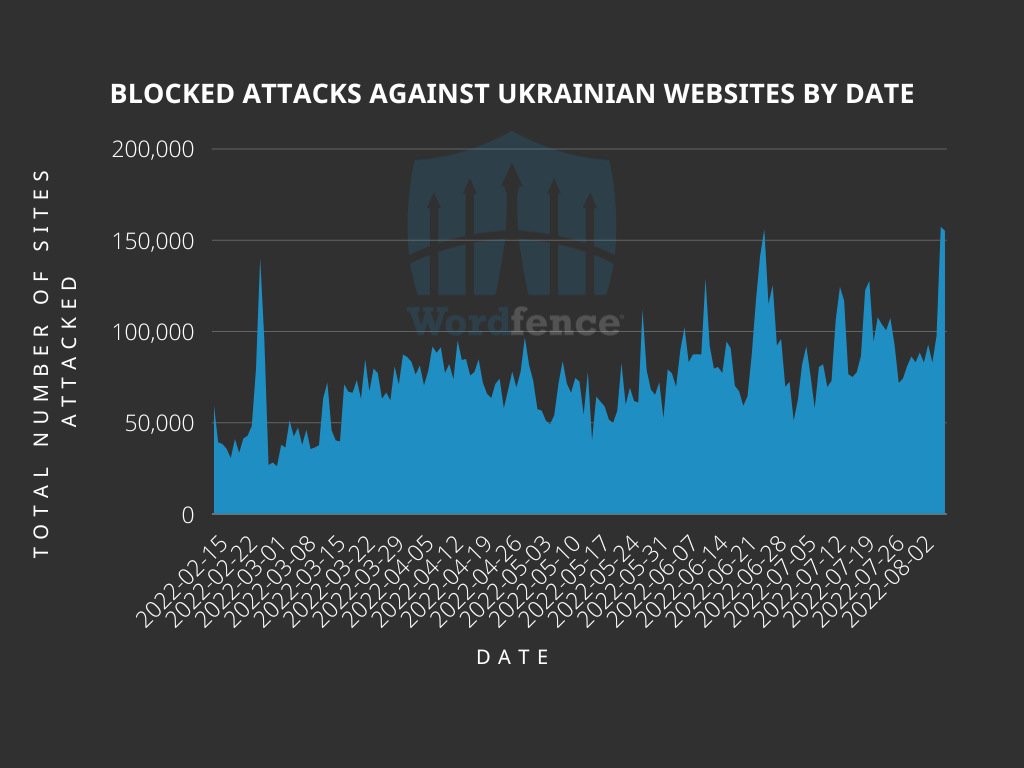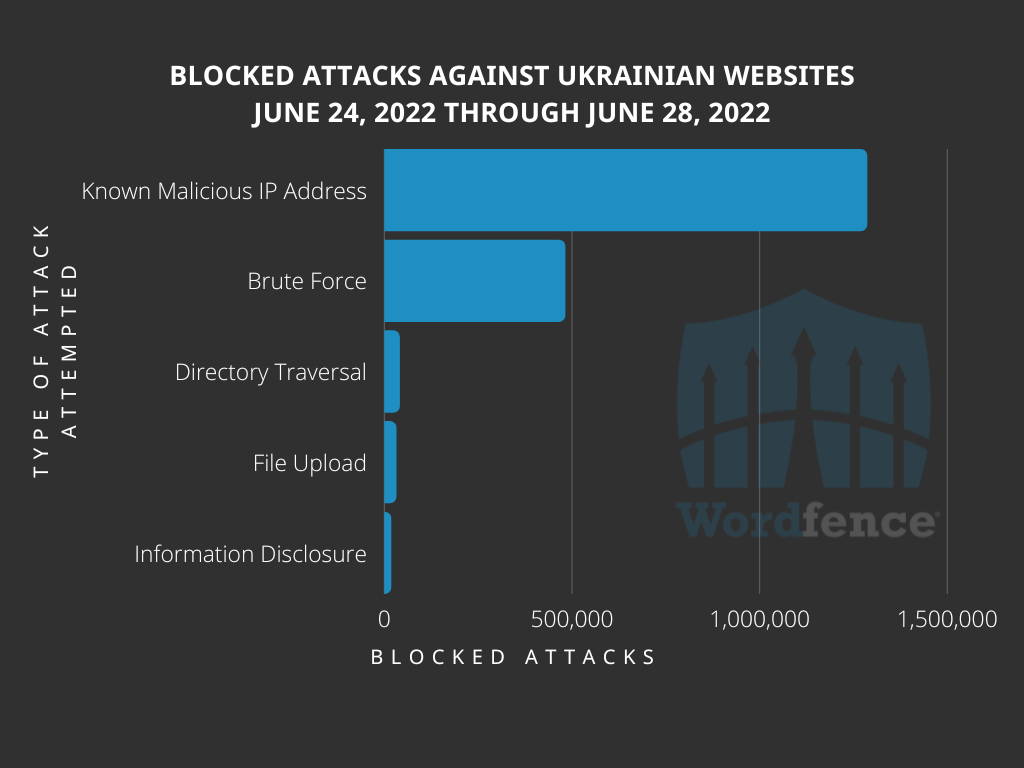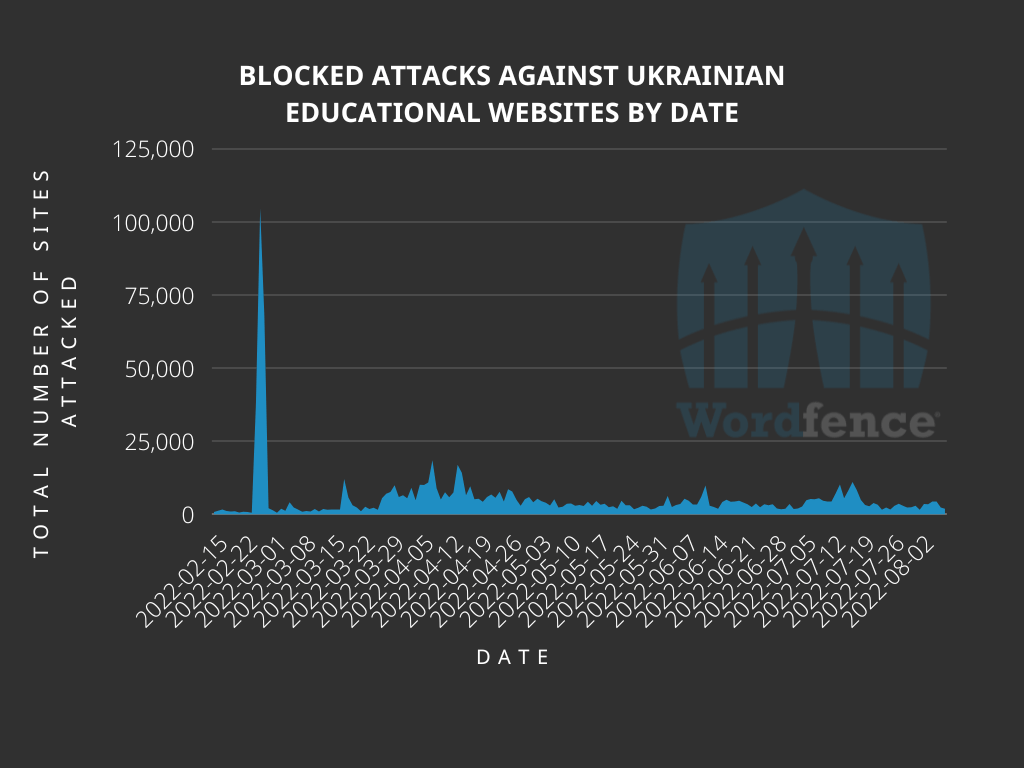Ukrainian Website Threat Landscape Throughout 2022
The Russian invasion of Ukraine began on February 20, 2022. By mid-March it was clear the cyber-war had begun, and the attacks have been consistent ever since. Prior to this, on March 1, 2022, Wordfence reported on an attack campaign on Ukrainian university websites. In response, we deployed our real-time threat intelligence to all sites running Wordfence with a .ua top-level domain (TLD). In the following months, we have continued to monitor the situation, and to block attack attempts aimed at Ukrainian websites.
Based on the data we have tracked, it has become clear that most of the attacks being levied against Ukrainian entities since the initial campaign are fairly routine, though regularly increasing in quantity. While there are some more sophisticated attacks, the vast majority of what we are seeing is routine spam content and defacements. These types of attacks are often perpetrated by lesser-skilled actors probing for easily exploitable random web targets with simple scripts. What we are seeing does not indicate the highly skilled and coordinated attacks that would be seen from larger criminal organizations or nation-state attackers.
Today’s post will focus on the quantitative threat landscape targeting Ukrainian websites that we’ve monitored in 2022, while next week we will follow-up with an article diving deeper into the attack data and exploits we are seeing targeting Ukrainian domains.
Broader Attacks Increasing in Volume
As we approach the six-month mark since the initial invasion, the cyber-front remains a volatile but constant battleground. Just after the invasion officially began, there was a spike in attacks against Ukrainian websites, then things were quiet for almost a week. At that point, on March 3, 2022, a barrage of attack attempts were brought against Ukrainian websites, with these attacks not only continuing, but generally increasing as the war continued. At first, the attack attempts were close to normal levels, but quickly increased to more than 50,000 attempts per day.
In the six months leading up to February 20, 2022 there were an average of just over 52,480 attack attempts against .ua websites blocked by the Wordfence firewall per day. The average during the conflict has increased almost 50% to nearly 75,000 attack attempts blocked per day, excluding any exploits coming from blocklisted IP Addresses.

The largest spike we have seen at this point began on June 24th, and subsided on the 28th. During this spike, we blocked 1,875,045 total attack attempts. In this time, most of the attack attempts were coming from known malicious IP addresses, with a substantial number of the attempts being brute force attacks. Directory traversal, file uploads, and information disclosure rounded out the most common attack types. There are no indicators in our data that these attacks were connected, meaning it is likely that this was not a large attacking organization, but rather a concerted effort from many smaller groups and individuals.
Wordfence deployed its real-time threat intelligence, which includes an IP Blocklist, to all .ua domains on March 1, 2022. The IP blocklist is updated in real-time to block the latest active known threats and is very effective at doing so. It provides a drastic increase in protection on any sites running the Wordfence firewall due to the simple fact that an IP that targets several sites will end up on the blocklist before they can target many more. As such, we excluded this data from our attack data trends to demonstrate the general threat landscape, without the added benefit of Wordfence real-time Threat Intelligence, a feature of Wordfence Premium, Wordfence Care, and Wordfence Response, to be comparative with the attack data we saw before we made that deployment. Astonishingly, once we added the real-time IP blocklist attack data to our analysis, the percentage of attacks the Wordfence firewall blocked on all .ua domains jumped nearly 450% demonstrating the effectiveness of deploying our real-time Threat Intelligence to those domains.

The spike at the beginning of the invasion largely consisted of attacks against Ukrainian educational institutions as part of a defacement campaign. While these institutions have continued to experience attack attempts, they have not been as directly targeted since the initial attack on Universities in February. At the same time, the rate of attacks brought against educational institutions has remained higher than pre-invasion levels, with (comparatively small) spikes primarily in March, April, and July. The trend continues upward, with the average number of daily attack attempts per day nearing the 100,000 mark. Since the invasion began, we have logged 46,698,709 attack attempts against .ua domains. Of those attempts, 2,903,923 were against .edu.ua domains, and 1,903,806 were against .gov.ua domains.

A Shift In The Threat Landscape
When we first wrote about the attack on Ukrainian universities, there was one IP address, 185.193.127.179, that stood out as the primary attacking IP. The IP address was registered through Njalla, a hosting company that is run by the co-founder of Pirate Bay. After the initial attack against the universities subsided, there is no indication that this IP address has been reused in further attacks against Ukraine.
The top attacking IP currently is 62.233.50.223, which is assigned to Chang Way Technologies. The company is based in Hong Kong, but the IP address is assigned to a server located in Russia and registered to the Russian organization Sierra LLC. The IP block this address is a part of was registered to Sierra LLC on October 13, 2021. In contrast to the 104,098 attack attempts in a single day by the Njalla IP address that attacked universities in February, the Sierra LLC. IP address is only responsible for 205,223 attack attempts in 30 days, and those attempts were not targeted against a specific type of potential victim.
Despite the fact that this IP address does not appear to be targeting victims in any particular industry, the attacks coming from this address are relatively consistent. The majority of what we are seeing from this IP address is SQL injection attacks, sending a GET request to the site with the payload in a URL encoded string, as seen here.

With this string decoded, it begins to look more like a normal SQL query, though portions are using character encoding which we see here as CHR encoded strings.

When we convert this and combine the string as is the purpose of the || operator, we end with this final payload string.
![]()
This is essentially using the SQL CASE statement to iterate through options to determine if specific content exists within the database, and uses the CAST statement to convert content to a specific data type. As with many attacks, this does not mean that a SQL injection vulnerability is present, or that the desired content is in the database. This is the malicious actor fishing for information, and hoping they get something in return.
Similar to the lack of focus we are seeing with the types of attacks, there does not appear to be any primary attacker in recent attempts. While the top nine attacking IP addresses are responsible for more than 50,000 attack attempts each, there is a long tail of IP addresses responsible for just under 50,000 attacks each and slowly working down to sub-100 volumes. This is a fairly typical pattern in attack data, rather than having one attacking organization stand out above the others.

Conclusion
In this post, we reviewed the data collected from attack attempts against Ukrainian domains with a .ua TLD since the beginning of the Russian invasion of Ukraine on February 20, 2022. The initial attacks we saw were very targeted around educational institutions, however the attacks we have been blocking since the initial campaign have been much more varied. Attack attempts are coming from a variety of malicious actors, in varying locations. The volume of attack attempts has remained high compared to pre-invasion levels, but with our continued protection these attempts are blocked, preventing damage to Ukrainian websites.
If you want to know more about the types of attacks we are blocking on Ukrainian websites, keep an eye on the Wordfence blog. A post next week will discuss these attacks, the vulnerabilities they are attempting to exploit, and how malicious actors can use them to damage an affected website.
Wordfence deployed Real-Time Threat Intelligence, an exclusive feature of Wordfence Premium, Wordfence Care, and Wordfence Response, to all .ua domain names regardless of their product tier. This means that all .ua domains, including those running Wordfence Free, have the latest protection against the newest threats, including vulnerabilities, IP addresses, and malware.
If you believe your site has been compromised as a result of a vulnerability, we offer Incident Response services via Wordfence Care. If you need your site cleaned immediately, Wordfence Response offers the same service with 24/7/365 availability and a 1-hour response time. Both of these products include hands-on support in case you need further assistance.
This article was written by Topher Tebow, a former Wordfence Threat Researcher.


Comments